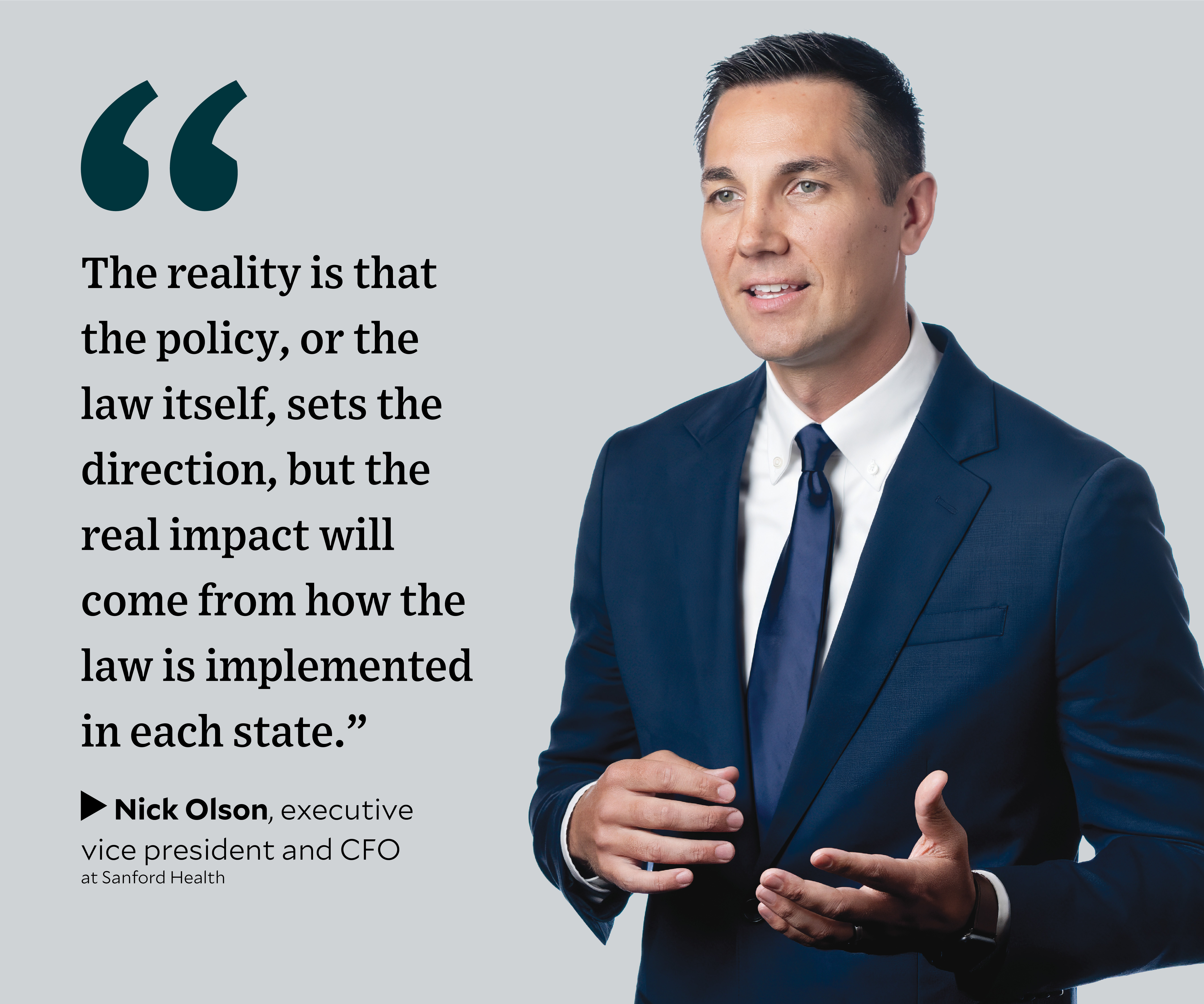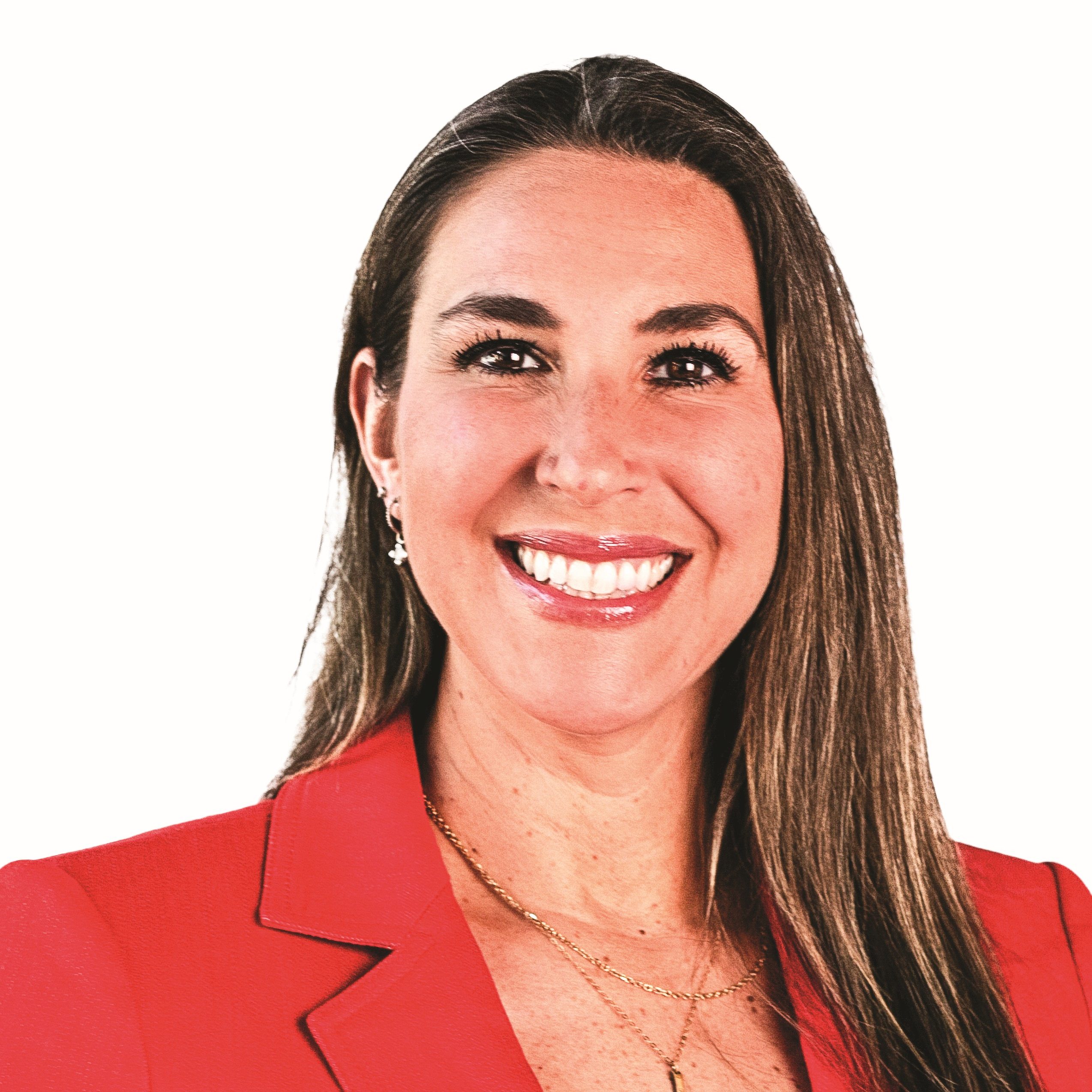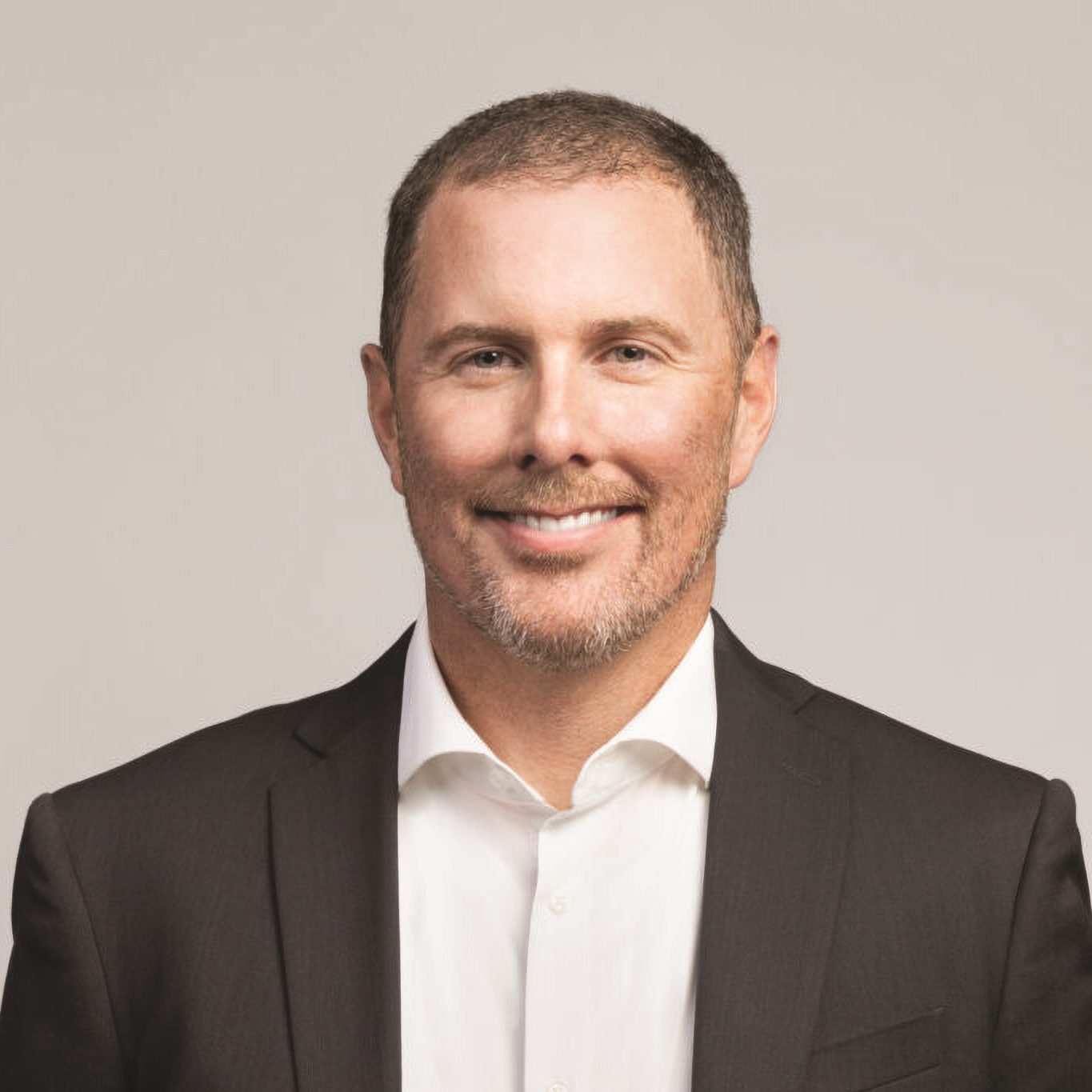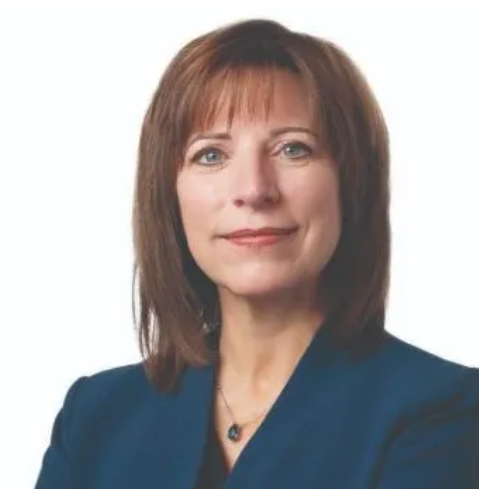Hospitals brace for looming federal cuts in Medicaid and elsewhere
The One Big Beautiful Bill Act is expected to have a major financial impact everywhere, but for some states, the repercussions will be particularly daunting.

The historic healthcare policy changes — and associated Medicaid cuts — in the One Big Beautiful Bill Act have left it to the states to figure out how to keep their residents insured and healthy with $1 trillion less in federal funding.
With impacts of the One Big Beautiful Bill Act, or OBBBA, including a variety of changes that potentially will reduce Medicaid eligibility, covered services and provider reimbursement, hospitals and health system executives are scrambling to both understand the coming effects and connect with state leaders on implementing the law
“The reality is that the policy, or the law itself, sets the direction, but the real impact will come from how the law is implemented in each state,” said Nick Olson, executive vice president and CFO at Sanford Health, a seven-state system based in Sioux Falls, South Dakota. “We’re really looking to help make recommendations for our state leaders, and we think that there’s a lot of opportunity to collaborate.”
The law will cut projected federal healthcare spending by over $1 trillion — including more than $900 billion from Medicaid — over 10 years through a range of policy changes.
“You can’t start with, ‘We’re losing that much [in funding],’ and not have an impact on providers for care delivery, for staff, for patient access to care,” said Sean Kolmer, a policy expert with the Hospital Association of Oregon.
Initial outlook
The changes that will pose particular challenges for hospitals and state Medicaid programs include complicated new work requirements for enrollees, more frequent eligibility checks and limits on state-directed payments (SDPs) and provider taxes.

“Probably the biggest missing piece right now is administrative guidance from CMS [implementing OBBBA provisions], which may be some time coming,” said John Connolly, PhD, MSE, Minnesota’s Medicaid director and deputy commissioner of the state’s Department of Human Services, in July.
Although sweeping pronouncements about the nationwide impact are difficult, given variation in state regulations and demographics, states with large Medicaid expansions and relatively large populations of undocumented immigrants generally will see the biggest impacts from OBBBA’s provisions.
Lost federal funding will have the biggest impact on services where the payer mix tilts toward Medicaid.
“You’re seeing that states are really facing needs in behavioral health,” said Verlon Johnson, MPA, speaking from a personal perspective. (In her professional role, Johnson is executive vice president and chief strategy officer at McLean, Virginia-based Acentra Health and chair of the Medicaid and CHIP Payment and Access Commission.)
“Maternal health has also been a huge concern when you recognize that 40% of all births in America are covered by the Medicaid program. And then also long-term care services,” Johnson said.
(See also the sidebars “Healthcare organizations prepare for financial fallout” and “What hospitals can expect from the $50 billion rural healthcare fund” at the end of this article.)
The work requirement
CMS regulatory guidance to states on the work requirement, including how states can apply for up to a two-year delay, is not due until June 2026. That would allow only six months to launch programs or obtain an extension before the Dec. 31, 2026, start date.
Some doubt the Trump administration will routinely approve delays.
If a state tells HHS, “‘We’re really trying to get there, we’re close, we just need a little bit more time because the procurement for something was more complicated or took longer than we thought,’ would the administration grant them some kind of delay? Probably, but I absolutely do not think it’s going to be a get-out-of-jail-free card for anybody,” said Matt Salo, a consultant and former executive director of the National Association of Medicaid Directors, based in Washington, D.C.
Altogether, states will receive $200 million in first-year federal funds to implement the work requirement, which will apply to expansion enrollees ages 19 to 64 while exempting enrollees such as parents with children younger than 14 and people with disabilities.
Whether that funding will adequately cover all 40 expansion states is unknown. The Government Accountability Office (GAO) found in a 2019 report that implementing work requirements would cost more than $270 million in Kentucky alone.
“The types of things that states have to do [are] really significant,” said Kinda Serafi, partner at Manatt Health.
Past experience
A few states have experience with work requirements, including Georgia, which implemented a requirement in 2023 and is the only state with a currently active program.
Arkansas had a requirement for most beneficiaries ages 30 to 49 in 2018-19, before a lawsuit shut it down. More than 18,000 Medicaid enrollees lost coverage over five months, comprising roughly 25% of those subject to the requirement.
According to analyses, most of the coverage loss stemmed from administrative issues such as enrollees’ inability to report their work activity.
“If you messed up reporting for three months — and those three months did not have to be consecutive — then you were kicked off,” said Jodiane Tritt, executive vice president with the Arkansas Hospital Association.

Jodiane Tritt, executive vice president with the Arkansas Hospital Association
States such as Minnesota, where the Medicaid program is administered by 80-plus counties, arguably face greater challenges implementing the work requirement.
“You can imagine the confusion that can crop up about who I [as a patient] need to talk to,” said Joe Schindler, a vice president at the Minnesota Hospital Association. “Are [counties] going to be overburdened? The answer is ‘Yes.’”

Successful implementation of the work requirement will require collaboration among multiple stakeholder groups. Nonetheless, the six-month implementation timeline seems reasonable to some organizations.
“We feel like that runway is really going to give us time to minimize any material impacts as we start to work with the state to look at how we can make sure that as few people as possible are losing access to their Medicaid coverage,” Sanford Health’s Olson said.
Other challenges
Unlike with the work requirement, no delay is available for the Dec. 31, 2026, start of the mandate to check eligibility of expansion enrollees every six months — an increase from once annually in most states.
“[Stakeholders] were really anxious about [redeterminations] during the [Medicaid] unwinding period where states were doing all these renewals,” Serafi said. “Now imagine that, but on steroids.”
Unlike the one-time post-COVID-19 redeterminations, states will have to perform twice-annual eligibility checks for the foreseeable future. Hospital officials see the potential for significant confusion, especially in emergency
care situations.
“If a patient is admitted to the hospital with a serious condition and they’re going to [lose Medicaid eligibility] five days from now, and we don’t know that in the hospital, we’re very concerned about what happens to keep that person enrolled and [with] the eligibility check,” Tritt said.
Providers plan to do what they can to help.
“We are thinking through supporting ways to partner with states to help automate and streamline the process, the digital tools that we can help build and assist with, and [how to] provide enrollment support at places where we provide that care, such as walk-in clinics,” Olson said.
Another point of concern in the OBBBA is the copay requirement for Medicaid beneficiaries. Minnesota previously tried requiring small copays for emergency services, making Schindler wary about the impact of a provision to require $35 copays from expansion enrollees receiving many Medicaid-covered services starting in 2028.
“[The copays] were like a dollar or three dollars, and even those amounts were unable to be paid or were not being paid,” he said. “If there’s a $35 bill, we are highly concerned that’s just going to be a hospital write-off.”
Also notable are OBBBA-required cuts to Medicaid retroactive eligibility from three months to one month for expansion enrollees and two months for traditional beneficiaries.
Funding mechanisms curtailed
States will see cuts in federal funding made via the SDPs that allow Medicaid managed care organizations (MCOs) to increase Medicaid pay rates for various providers. The payment rates can be as high as the average commercial rate but soon will be capped at 100% of the Medicare rate in expansion states and 110% in non-expansion states. A 10% annual phase-down from current rates begins in 2028.
That same year, the provider taxes that support a significant share of Medicaid payment in many states by drawing in federal matching funds will begin a five-year reduction in expansion states from 6% to 3.5% of a hospital’s net patient revenue. Non-expansion states are exempt from the reduction but cannot create new tax arrangements or raise their current rates.
In contrast to the federal government, more than 40 states have some type of balanced-budget requirement. And most cannot carry over a deficit to the next year. Thus, Medicaid shortfalls will require strategic decisions and potentially significant reallocations.
“Everybody’s going to take a haircut in order to bring the budget back into balance, and that’s going to include the [Medicaid] health plans, that’s going to include the hospitals and everybody else,” Salo said.
Cuts will vary in size
Yet the prospective impacts are far from uniform. In Oregon, provider tax revenue has been “an underpinning to how we fund coverage and Medicaid,” Kolmer said.

Sean Kolmer, policy expert with the Hospital Association of Oregon
The governor’s office projects the new restrictions will cut more than $2.3 billion from Oregon’s Medicaid program through 2031.
“It’s going to cause hard conversations at the state level about who we can cover in Medicaid, how we can cover them and how we can pay providers of all types,” Kolmer said.
The provider tax cuts will not affect Medicaid funding in Arkansas because the state’s tax has been set at only 2% of net patient revenue, but now the state loses any chance to enact new or expanded taxes.
“We’re sort of left out of any other options to improve our supplemental payment program, and that’s really disappointing,” Tritt said.
Minnesota’s Medicaid program will lose 140,000 enrollees and $1.4 billion in federal funding over four years, with new administrative costs accumulating for counties, according to the state.
“Sometimes legislators are too quick to look at hospitals as a funding source, so to speak, for some of these kinds of [budgetary] shortfalls,” Schindler said.
As a non-expansion state, Florida faces less severe cutbacks. The state also was able to file an SDP proposal just before OBBBA froze those, but the Sunshine State’s hospitals are still concerned about whether Medicaid reimbursement will cover costs anywhere near adequately.
“It’s amazing what we ultimately declare a success,” said Mary Mayhew, president and CEO of the Florida Hospital Association.
The seven states in which Sanford Health operates across the rural upper Midwest do not materially benefit from SDPs, and none have provider taxes higher than the 3.5% cap. The health system has managed to thrive despite lacking support from such programs, Olson said.
“Sanford Health is an example where there is still a path forward of sustainability, even without those provider taxes, without those state-directed payments,” he said.
Hospitals look to weigh in
Hospital advocacy leaders pledge to help mitigate the impact on their states and communities in upcoming years.
That starts with ensuring they have a seat at the table for discussions on implementation.
Kirsten Largent, CPA, CFO of OSF HealthCare in Peoria, Illinois, with clinical operations also in Michigan, said her organization is in close contact with legislators in the two states.
That approach allows for “leveraging and being good partners with our legislators and making them aware of the impacts and the information necessary for them to make good decisions,” Largent said.
She also underscored the need for state hospital associations to improve communication with state legislators.
In Oregon, Kolmer said, “Our members are already making some of those decisions about the services they can provide so they can be viable entities that can provide access to their communities.
“We want them connected to the larger [policy] conversations about delivering care, providing coverage, providing benefits,” Kolmer said.
Medicaid managed care administrative costs arguably should be examined before any substantive service cuts or reimbursement reductions take place, he said.
Hospital lobbying also will aim to at least partially reverse the most severe impacts of OBBBA, said Steve Ahnen, president of the New Hampshire Hospital Association.
“When people start to feel that it’s more difficult to access the healthcare system, when it’s more costly, when it’s more fragmented, I think [policymakers] are going to say, ‘Hey, wait a minute, that’s not what we signed up for,’ and will be looking to make some changes,” he said.
Healthcare organizations prepare for financial fallout
Given the potential for wide variation in state implementation of policies required by the One Big Beautiful Bill Act (OBBBA), hospitals and health systems are developing financial projections and plans for different scenarios.
A need to strategize

Industry leaders say advance planning could be critical, since those organizations will bear the brunt of more than $1 trillion in 10-year federal healthcare cuts.
Kirsten Largent, CPA, CFO of OSF HealthCare in Peoria, Illinois, said her organization is “planning for our best estimate of when items will impact us from a timing and dollars perspective. But then at the same time, we’re also developing contingency plans.”
OSF also has boosted its annual cost reduction target for 2026 to $100 million in anticipation of OBBBA cuts starting to bite in 2027. The system achieved $64 million in operational efficiency improvements in FY24, and it forecast an additional $30 million in improvements for FY25, according to Moody’s.
Beyond productivity and cost control initiatives, Largent said OSF is questioning how it can fundamentally change its cost structure to prepare for significant reimbursement reductions.
Revenue initiatives in anticipation of federal cuts include continued outpatient-facility expansion to increase capacity for higher-acuity patients.
Technology options
At Sanford Health in South Dakota, executives also plan both cost control and revenue growth in response to the headwinds of the new law.
Instead of service line cuts, the health system is undertaking an aggressive technology-driven efficiency push. That includes increasing investment in generative AI or other technologies to automate more manual processes.
For example, Sanford plans to expand on a 2024 initiative to automate radiology coding.
Austerity coming
Matt Salo, a consultant and former executive director of the National Association of Medicaid Directors, based in Washington, D.C., said hospitals should prepare for financial austerity.
“This is not the time, unfortunately, to be thinking about how you expand access, how you build out your capital infrastructure, even though that may be an important goal,” Salo said.
Instead, he urged organizations to double down on fraud-fighting and waste-cutting initiatives.
“You put some of those [other projects] on the backburner, unfortunately, and you start listening more to the [people] who say, ‘Hey, we can help shrink some of those financial deficits,’” Salo said.
What hospitals can expect from the $50 billion rural healthcare fund
Congress tried to ameliorate the impact of the budget reconciliation bill on vulnerable rural providers by creating the $50 billion Rural Health Transformation Program.
“It’s not exactly the amount of money that would [be needed] to mitigate some of the losses in the rural hospital sector, but it’s … welcome relief if and when we get that funding,” said Joe Schindler, a vice president with the Minnesota Hospital Association.

How the funding will work
Disbursements in five annual installments of $10 billion will begin in 2026. Medicaid programs or governor’s offices are supposed to submit a plan to CMS by Nov. 5, describing how they will use the money to improve care access, attain financial stability for rural hospitals and make other upgrades. The agency spelled out requirements for those state plans in September guidance.
Each year, all states that submit a successful application will receive an equal share of a $5 billion overall disbursement. CMS will dole out the other $5 billion based on discretionary factors.
Sean Kolmer, a policy expert for the Hospital Association of Oregon, worried states might keep some of the funding to cover administrative costs or consultant work. CMS will limit such applications to 10%.
“We don’t think that should have anything to do with this money,” Kolmer said.
Putting the money to use
Hospitals can apply program funding to boost the workforce, including professional development for clinicians, said Steve Ahnen, president of the New Hampshire Hospital Association.
He said another possible idea is a supplemental per diem payment for hospitals where patients are boarding after they should have been discharged, due to a lack of post-acute care.
Applications could also include creating uncompensated care pools for people kicked off Medicaid because of administrative snags, said Jodiane Tritt, executive vice president with the Arkansas Hospital Association. Other uses could include long-needed facility upgrades.
Possible state applications
Nick Olson, executive vice president and CFO at Sanford Health, said his organization will encourage states to use the funds to scale high-impact programs that already work, including virtual care for mental health in remote areas and recruitment of clinicians to provide that care.
Expansion of Sanford satellite clinics also would allow more patients without broadband access to receive virtual care, he said. \Olson said it’s critical the funds go to “shovel-ready” projects focused on rural and Medicaid patients, rather than to fund operations or deficits.
OSF Healthcare, based in Peoria, Illinois, intends to use the funds to expand rural access through virtual care, said CFO Kirsten Largent, CPA.
“When I think about virtual care and the expansion and the utilization of technology to improve access and lower costs, particularly in the rural market, I think that would be a significant leap from the path that we’ve been on,” she said.





